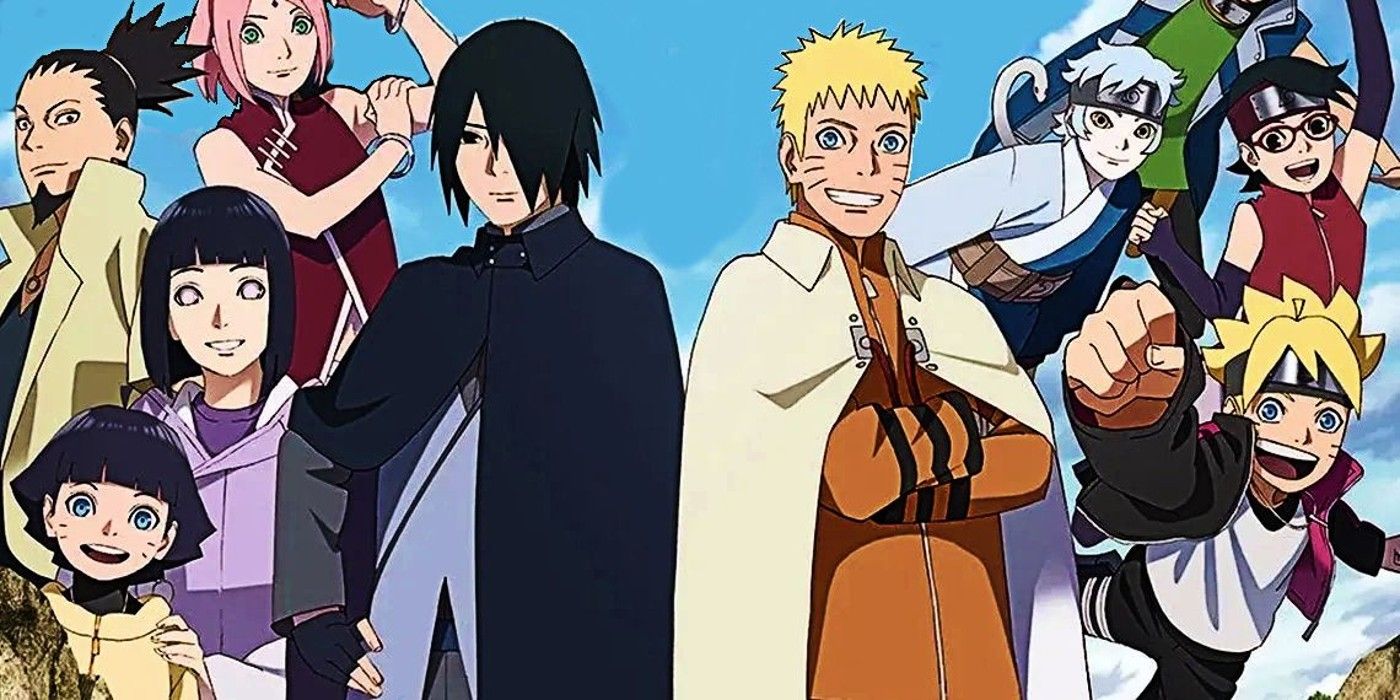The biggest gripe fans have with Boruto: Naruto Next Generations is the amount of filler it has. With an allegedly whopping 70 percent of the show containing filler episodes, the need for a guide to maneuver the manga canon and fillers is needed.
The reason Boruto: Naruto Next Generations contains so many filler episodes is that the studio adapting it needs to give the manga author time to stay ahead of the series. This is made worse because the manga releases chapters monthly as opposed to weekly. Nonetheless, the series, even with filler, is still very popular and enjoyed by many.
Boruto Filler List
|
Episode/Arc Title |
Episode |
Watch or Skip? |
Reason |
|---|---|---|---|
|
Academy Entrance Arc |
16-17 |
Watch |
Based on the light novel, it helps to establish all the new characters and build a repertoire. |
|
Genin Mission Arc |
40-41 |
Watch |
As Boruto’s team’s first mission, it’s a great insight into their teamwork and compatibility. |
|
Byakuya Gang Arc |
48-50 |
Skip |
|
|
Chocho Arc |
67-69 |
Skip |
|
|
Mitsuki’s Disappearance |
71-92 |
Watch |
A great arc into one of the more underrated characters in the new Team 7, Mitsuki |
|
Naruto Shinden Arc |
93-97 |
Watch? |
Centers on some sweet slice-of-life moments within the family. |
|
Curse Mark Arc |
98-105 |
Watch |
Partially centered on Jugo, it features some good fights and holds some insights for characters in later installments. |
|
Konoha Shinden & Konohamaru’s Love Arc |
112-119 |
Watch? |
Not entirely necessary for the canon or overall story, but there are some good Konohamaru moments. |
|
One Tail Escort |
120-126 |
Watch |
Serves to better Boruto’s character by showcasing his growth and maturity. |
|
Time Slip Arc |
128-140 |
Watch |
Referenced often, fans get to see a nostalgic return to Naruto’s heyday. |
|
Mujina Bandits Arc |
152-156 |
Watch |
Serves as a prelude to the Kara Arc |
|
The Funato Arc |
231-232 |
Skip |
|
|
The Great Kirigakure Arc |
256-260 |
Watch |
Features some fascinating fights and a return to Naruto’s themes of hatred fueling more conflict. |
|
Kawaki & Himawari Academy Arc |
261-273 |
Skip |
|
|
Labyrinth Games |
274-281 |
Watch |
While not too flashy, the arc is filled with some creative writing and good moments that add to the cast’s strong points. |
There are a total of 206 filler episodes in Boruto: Naruto Next Generations. While Naruto: Shippuden had about the same number of filler episodes, the latter series had a total of 500 episodes, whereas Boruto only has a total of 293 episodes. This means that 70% of Boruto is filler, which is quite high compared to Naruto & Shippuden’s 41% and Bleach’s 45% of filler episodes.
Studio Pierrot is notorious for introducing side stories not present in the manga, like in the case of Bleach and Naruto: Shippuden. Filler episodes and arcs are often used to give manga creators some breathing room and time to put out more chapters. Studio Pierrot produces year-round episodes, so it makes sense why they’re always catching up to the source material. When the source material is fully present, like in the case of Bleach Thousand Year Blood War, there are zero filler episodes present, and the manga is faithfully adapted.
Which of Boruto’s Filler Episodes are Worth Watching?
Some of Boruto’s Filler Actually Adds a Lot to the Series
Contrary to popular narrative, Boruto does have fillers worth giving a chance. Despite most of the episodes being filler, the series is incredibly successful. The most obvious Boruto filler arc worth watching is Mitsuki’s Disappearance Arc.
Mitsuki has always been a fan favorite, but didn’t get a backstory in the manga. The arc featured one of the best fights in the series between Orochimaru and Log. Another arc worth watching is the Time Slip arc, where Sasuke and Boruto go back in time and meet the young Naruto cast and Jiraiya.
Which Boruto Filler Episodes Should Be Avoided?
Unfortunately, not all of the series’ filler is top quality. Episode 49 Wasabi & Namida is often cited among Boruto fans as one of the series’ most boring filler episodes. The episode follows the titular Wasabi and Namida as they bicker about how best to tackle a mission involving saving animals. Wasabi and Namida aren’t particularly well-developed characters and have very little bearing on the overall plot, so the episode focusing on them doesn’t add up to much.
In terms of entire arcs, the Super Chocho Love arc is also seen as a step down in quality. The arc sees Chocho assigned to protect a celebrity she has a crush on, causing the young ninja to change her appearance through ninjutsu to earn his affection. While the episode might have good intentions in that it’s largely about body positivity and not changing for other people, it’s undermined by a largely forgettable story.
Will Boruto Two Blue Vortex’s Anime Contain Filler?
With Boruto’s anime wrapped up in March 2023, many fans are still eagerly awaiting its return, where it would presumably pick up the last remaining arcs from Naruto Next Generation before transitioning into Two Blue Vortex. The sequel thus far has gained significant ground ahead of the anime, considering that its unannounced hiatus stopped before concluding its first part.
Since Two Blue Vortex was released, fans have come to have an all-new appreciation for Boruto and his companions now that a time jump has ushered forth a similar wave of maturity amongst the cast, similar to how Shippuden allowed its time skip to allow its cast to grow. However, the anime would not be able to return the same.
Now that Boruto’s part 2 has been inadvertently confirmed by an announcement made on Pierrot’s website, the anime is set to return to production. But it won’t be able to carry out the same formula as before.
To avoid the issue of the anime catching up to the manga once more, Studio Pierrot is going to have to adapt Boruto as a seasonal anime rather than continue to run it as an annual one. Given Demon Slayer and Bleach: Thousand-Year Blood War’s critical success, this model has proven to be the optimal decision going forward.
Not only would a seasonal release give the manga plenty of time to get ahead, but it would help Studio Pierrot avoid getting into too much filler that doesn’t add anything to the story. The anime would be allowed to focus solely on the story, the animation quality, and a select number of episodes released every few years or so.
Why Does Boruto Have so Much Filler Compared to Other Shōnen Anime?
Boruto‘s staggering 70% filler rate can actually be explained away by its annual approach to producing anime, given that it has been running concurrently with the Boruto: Naruto Next Generations manga story. Weekly Shōnen Jump’s former Editor-in-Chief, Hiroyuki Nakano, at Lucca Comics & Games 2018 explained that the manga and anime series were released in tandem instead of the typical manga-to-anime pattern. This allowed them to function and space themselves out accordingly while intersecting at key moments without contrasting too sharply, as transcribed and translated from anime.everyeye.it.
“Usually manga and anime travel on the same line. Usually the manga is made first and then it is transposed into anime. Instead, in this case, manga and anime are two distinct blocks, but in order not to contrast themselves too much they choose to travel different paths and then intersect at the same point in the finale. All of this, obviously, subject to our creative and editorial control .”
-Hiroyuki Nakano
The idea of two separate series operating independently of each other while adhering to the same root canon, with the anime expanding on itself to have still “canonical” filler, results in a complicated perception of the show’s content. Taking Nakano’s words at face value, it’s possible to take what’s commonly accepted by audiences as a form of “mixed canon” episodes, which total between 174 and 186, leaving only a remainder of 20-32 genuine, missable installments. This is crucial because fans wishing to see characters sidelined, even in the manga, like Metal Lee, will get their chance in these filler episodes.
On top of the anime’s debut on April 5, 2017, running so close to the manga’s original release, May 9, 2016, Boruto changed publications in June 2019 to V Jump, changing its release pattern to a monthly one. With only a four-month gap between Boruto: Naruto Next Generations’ manga and Two Blue Vortex, and Pierrot’s decision to put the anime on hiatus possibly being related to ensuring its quality improves in future episodes, it’s clear this filler model was unsustainable.
Despite its Abundant Filler, Boruto is Still a Good Watch For Fans of Naruto
Boruto: Naruto Next Generations is widely considered to be almost entirely filler by critics of the anime and is often ridiculed for the scaling of its filler, which can range anywhere from 40 to 70% percent. Regardless of where you place it, there are still valuable arcs that can add to the overall experience of the show by expanding on characters who are often ignored or set aside. Whether by foreshadowing new abilities to introducing the Jougan, Boruto: Naruto Next Generations should be given a chance.

Boruto: Naruto Next Generations
- Release Date
-
2017 – 2023-00-00
- Network
-
TV Tokyo
- Directors
-
Yusuke Onoda, Tazumi Mukaiyama, Michita Shiraishi, Youichirou Aoki, Shigetaka Ikeda, Taiki Nishimura, Rokou Ogiwara, Mitsuo Hashimoto, Hikaru Sato, Akira Shimizu, Norihiko Nagahama, Takashi Asami, Hodaka Kuramoto, Kiyomu Fukuda, Yoji Sato, Masatoyo Takada, Hazuki Mizumoto, Natsumi Yasue, Hideaki Ōba, Masaaki Kumagai, Mihiro Yamaguchi, Shigenori Kageyama, Nanako Shimazaki
-

Yuko Sanpei
Uzumaki Boruto (voice)
-

Cocoro Kikuchi
Uchiha Sarada (voice)
Source: anime.everyeye.it



